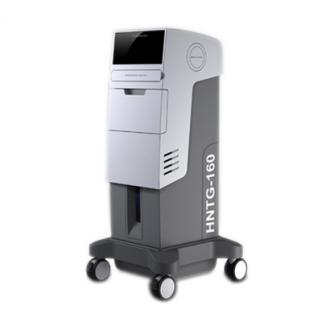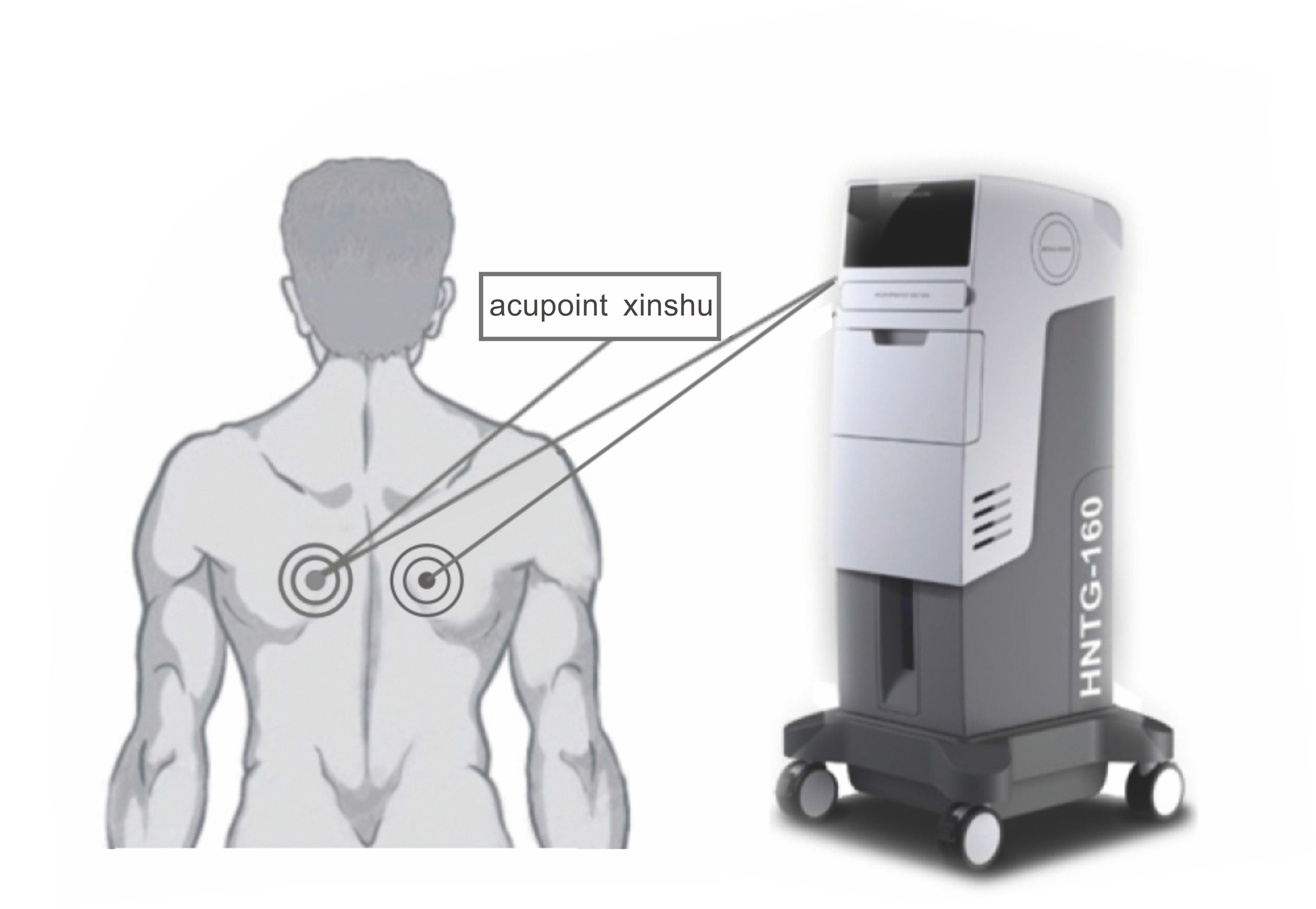
New breakthroughs of Physical therapeutic instrument for coronary Artery disease
Product Name
High-energy Bio-ion Instrument for Coronary Artery Disease
Product Structure
Host Output line Two Physical probe
Mechanism of action
According to the conductance fundamental equilibrium principle of biological electrophysiological and biological tissue ,High-energy bio-ion instrument for coronary artery disease convert biological ion wave to bio-electric ion and re-integrate the disordered charge for diseased tissue( nerves, bloods, muscles) to restore their normal function when it effects on human body. Especially its high technology not only broke through the difficulties that traditional physical therapy factor is hard to penetrate deeply into human organs and tissues, but also according to the principle of TCM meridian, combined the therapy of acupuncture and moxibustion with the effect of biological ionizing to get excellent physiological and therapeutic effects, and achieve its effect:
a. Restore the vasomotion in resistance vessel, relieve wall fibrosis, change the status of vascular stenosis,make the vascular softened and reduce blood pressure.
b. Improve microcirculation, increase myocardialinfarction lesion area's blood provide, as well as improve the ischemic injury of myocardial tissue and promote nerve function to activate.
c. Relieve myocardial degeneration and the fibrillation of myocardial cell atrophy interstitial, improve coronary atherosclerosis and the status of cardiac hypertrophy.
d. Increase the motion of electric charges of nerve cells membrane (inside and outside);improve nerve inflammation edema, enhance the activity of neuronal cell and resurrect nerve function.
Clinical characteristics
a. Short-term treatment will significantly improve the main symptoms of angina and shortness of breath.
b. Long-term treatment will improve the blood supply of coronary, repair the organization of myocardial infarction, delay the progress of disease, and make patients to full recovery. No any treated patient is happened depends on heart surgery or cardiac interventional treatment due to the protracted illness.
c. It has been proved by case-by –case that the methods for rescuing patients with acute myocardial infarction are more effective than regular methods.
d. Simply physical treatment, safety, no toxic side effect.
Adaptation disease
a.Initial onset angina pectoris: patients with angina pectoris within one month.
b.Stable angina pectoris: patients with angina pectoris more than one month
c.Progressive angina pectoris: chest pain that induced by the same degree of fatigue is happen frequency, the severity and duration is also suddently increasing.
d.It has been tested and confirmed as the treatment of patients with acute myocardial infarction in acute and convalescent stages.
Exclusion criteria
a. Angina pectoris at test
b. The chest pain caused by other heart disease, severe neurosis, menopausal syndrome, cervical spondylosis, gallbladder and the reflux of stomach and esophageal.
Contraindication
a. Patients who had cardiac surgery or interventional cardiology treatment.
b. Patients with severe primary disease, including severe hypertension, severe cardiopulmonary dysfunction, severe arrhythmia, as well as the severe primary disease caused by liver, kidney, and hematopoietic system.
c. Patients with malignant tumors, bone deformities, internal bleeding, glaucoma and other serious diseases.
d. Psychiatric patients
e. Pregnant or lactating women
f. Children under 12 years old.
Methods of operation
Patients with posterior wall myocardial infarction are proposal method A; patients with anterior wall myocardial infarction are proposal method B.
Method A: Place two physical probes in parallel to patients’ back [figure 1]
Let the patient supine to press the physical probes, setting the treatment time for 20 minutes, then slowly adjusting the fine-tuning to make the treatment current increase to the patient tolerance. The best treatment current is 10-20 mA, plus the stalls when current is not enough, and the current should not exceed 30 mA.

1.The treatment for Initial onset angina pectoris
Twice a day, each time 20 minutes. Course of treatment should be increased until the major indexes have improved to achieve effective standards if the efficacies of main symptoms have improved after three times’ treatments. Then take the re-examination and follow-up the efficacy after 30 days.Give up this treatment method if it failed to improve the main symptom efficacy or major indexes after the treatment accumulated to five times.
2.The treatment for stable angina pectoris:
Twice a day, each time 20 minutes. Course of treatment should be increased until the major indexes have improved to achieve effective standards if the efficacies of main symptoms have improved after five times’treatments. Then take the re-examination and follow-up the efficacy after 20 days. Give up this treatment method if it failed to improve the main symptom efficacy or major indexes after the treatment accumulated to ten times.
3.Treatment for Progressive angina pectoris
Twice a day, each time 20 minutes. Course of treatment should be increased until the major indexes have improved to achieve effective standards if the efficacies of main symptoms have improved after five times’ treatments. Then take the re-examination and follow-up the efficacy after 20 days. Give up this treatment method if it failed to improve the main symptom efficacy or major indexes after the treatment accumulated to twenty times for ten days.
4.Treatment for rescuing the patients with acute myocardial infarction.
Reference Method1,Method2 or Method3
5.The convalescent treatment for the patients with acute myocardial infarction
Reference Method 1, Method 2 or Method 3.
Adverse reactions
Contraindication

[摘要]:目的 探讨高能生物离子治疗稳定型和不稳定型心绞痛患者的疗效。方法选择冠心病心绞痛患者,给予常规抗心绞痛治疗(抗心肌缺血药物+抗血小板药物、抗凝药),分成两组进行观察。
①治疗组:在以上常规治疗基础上,加用海南天光高科技开发有限公司生产的高能生物离子治疗仪进行治疗,每次30分钟,10次为一个疗程。
②对照组:仅给予常规治疗。观察指标为心绞痛症状缓解率、心电图改善程度。结果 治疗后不稳定型心绞痛症状缓解有效率为90%,稳定型心绞痛症状缓解有效率为96.15%;心电图缺血改善有效率为86.27%,治疗后的24h动态心电图ST段总压低时间缩短以及ST段最大压低深度减少情况,与治疗前比较有明显改善,P<0.05。
结论 高能生物离子对心绞痛症状的近期改善有着肯定的疗效,值得临床进一步观察和推广。
[关键词]:高能生物离子 心绞痛
Clinical Analysis of Therapeutic Efectiveness on the patients of Angina Pectoris of Coronary Artery Disease with High-energy Bio-ion YAO Zhen,Chen Jing, Kong Yueqiong, Zheng Hailong, Rong Congwen, Liu Chan
Abstract Objectives To observe the therapeutic effectiveness of high-energy bio-ion in treatment of patients with angina pectoris of coronary artery disease. Methods 56 caese of coronary heart disease were divided into two groups: unstable angina pectoris (UAP) and stable angina pectoris (SAP). All of them weregiven with antimyocardial ischemia drugs. Some of them were also treated with high-energy bio-ion equipment (therapy group), which was manufactured by Hainan Tianguang Hi-technology Development Corporation and treated in 40 minutes per session, 10 sessions per course. Some of them were given only with antimyocardial ischemia drugs (control group). Rsults After therapy, the effective rate of symptom im provement in UAP group was 90% and in SAP was 96.15%. The effective rate of ECG improvement of ischemia in all patients was improved greatly. Conclusion The high-energy bio-ion is much effective for the recent action in angina pectoris.
[Key words]:high-energy bio-ion angina pectoris
冠心病是临床常见多发病,其以反复、病情危重为特点,日益威胁着广大患者的健康。本研究以高能生物离子治疗仪并采用单盲、自身对照方法对冠心病稳定型心绞痛和不稳定型心绞痛患者进行治疗,取得了较好的近期疗效,现将结果报道如下。
材料与方法
1.1 病例选择:
按国际心脏病学会和协会以及世界卫生组织(ISFC/WHO)临床命名联合标准化联合专题组1979年的《缺血型心脏病的命与诊断标准》,选择冠心病不稳定型心绞痛(UAP)患者30例,其中男性11例,女性19例,平均年龄66±12(52~71)岁;稳定型心绞痛(SAP)患者26例,其中男性9例,女性17例,平均年龄62±15(43~72)岁。伴发疾病中,在不稳定型心绞痛患者中,有高血压病者17例,Ⅱ型糖尿病者6例;稳定型心绞痛患者有高血压病者15例,Ⅱ型糖尿病者2例。
若3个月内患过脑血管意外、严重心肾功能不全者、新近心肌梗死者、未控制的糖尿病患者均排除在入选病例中。
1.2.治疗方法和观察指标:
所有病例入院后均常规应用硝酸酯类药物,部分用美托洛尔12.5mg~25mg,每日2次;静息状态下发生心绞痛者用地尔硫30mg,每日2~3次。经以上治疗效果不佳者方进入本研究。给予高能生物离子治疗仪治疗,治疗仪器采用海南天光高科技开发有限公司生产的高能生物离子治疗仪,输出电压50~100V,电流强度15~20mA,正弦波。患者取仰卧位,将两个物理探头平行放置在患者背部,让患者平卧使背部压紧物理探头。设置治疗时间20分钟,缓慢调节微调使治疗电流增加至患者可耐受程度。最佳治疗电流为10-20mA,电流达不到时可加档位,最大不得超过30mA。每次治疗时间20分钟,共10天为一疗程。
接受高能生物离子治疗仪的治疗前后均常规检查血糖、血脂、心肌酶(CK-MB、TnT),以及纤维蛋白原(FN)、心电图和动态心电图等检查,每次治疗前后均观测心率、血压变化。
1.3.疗效判定:
参照1974年全国高血压冠心病普查预防座谈会制定的《冠心病心绞痛与心电图疗效评定标准》进行评定。
1.3.1.临床疗效
显效:心绞痛基本消失或减少80%以上,硝酸酯类耗量减少80%以上;
有效:心绞痛减少发作50%以上,硝酸酯类耗量减少50%~80%;
无效:心绞痛减少发作50%或硝酸酯类耗量未达到显效与有效的标准。
1.3.2.心电图判定标准
心肌缺血的心电图诊断:R波顶点垂线与ST段交叉≥90°,ST段呈水平型、下斜型下移≥0.05mv,以NST与∑ST表示心肌缺血的范围与程度,NST表示常规12导联中ST段压低的导联数,∑ST表示12导联ST段压低值的总和。疗效判定标准:
显效:休息时心电图恢复至正常或大致正常;
改善:压低的ST段治疗后回升≥0.05mv,但未达到正常水平。主要导联倒置T波变浅达20%以上或T波由低平变为直立;
无效:静息时心电图与治疗前相同。
1.3.3.动态心电图判定标准
采用Brewood动态心电图仪检测24小时心电图,在R波为主的检测导联中,ST段在J点后0.08秒呈水平型或下斜型压低0.1mv,持续1分钟以上,作为心肌缺血的诊断标准。
1.3.4.统计方法
所有计量资料结果以均数±标准差(X±S)表示,两组均值比较用非配对t检验判定。P<0.05为有统计学上的意义。
结 果
2.1.心绞痛缓解情况:
30例UAP患者中,显效16例,占53.33%;有效11例,占36.67%;无效3例,占10%;总有效率为90%;26例SAP患者中,显效17例,占65.38%;有效8例,占30.77%;无效1例,占3.85%;总有效率为96.15%。见表一。
| 各组患者的心绞痛缓解情况 |
| 显效 有效 无效 合计 |
| UAP组 16 11 3 30 SAP组 17 8 1 26 合计 33 19 4 56 |
30例UAP患者治疗前心绞痛发作次数总计为1564次,治疗后心绞痛发作次数总计为218次;治疗前消心痛治疗片剂为1260片/周,治疗后为630片/周。26例UAP患者治疗前心绞痛发作次数总计为782次,治疗后心绞痛发作次数总计为96次;治疗前消心痛治疗片剂为952片/周,治疗后为420片/周。治疗前后对比,在心绞痛发作次数、消心痛应用方面均有明显减少,P<0.01。
2.2. 心电图恢复情况:
56例心绞痛患者中有静息或动态心电图ST-T变化者51例,其中16例显效(31.37%),28例有效(54.9%),总有效率为86.27%;用药前后NST与∑ST比较见表二。
| 表二 治疗前后静息心电图NST与∑ST比较(X±S) |
| 治疗前 治疗后 |
| NST 2.8±1.2 2.2±1.2 ∑ST 3.2±1.7 2.3±1.1 |
△与治疗前相比,P<0.05;△△与治疗前相比,P<0.01。
| 表三 治疗前后静息心电图NST与∑ST比较(X±S) |
| 治疗前 治疗后 |
| ST段总压低时间(min) 504±40.2 546±51.2 ST段最大压低深度(mm) 3.6±1.5 2.5±1.2 |
△与治疗前相比,P<0.05。
| 表四 治疗前后血液流变学情况 |
| UAP组 SAP组 |
| 前 后 前 后 |
| TC(mmol/L) 5.85±0.82 5.12±0.94 5.67±0.73 5.03±0.81 Tg(mmol/L) 2.07±0.46 1.87±0.47 2.13±0.32 1.98±0.53 SOD(ng/L) 786±71.8 812±85.6 759±82.8 794±91.2 F(ng/L) 4.6±2.1 3.1±1.6 4.3±1.8 3.0±1.2 FDP(mg/L) 1.6±0.7 1.2±0.2 1.7±0.5 1.3±0.3 血液低切变速率 8.73±0.97 7.65±0.89 7.97±0.88 7.21±0.63 (10s-1mpa.s) 血液高切变速率 6.57±0.74 6.11±0.38 5.63±0.59 4.89±0.42 (10s-1mpa.s) 血浆粘度 1.43±0.31 1.06±0.23 1.52±0.27 1.02±0.24 PAG(M)% 76.19±12.78 70.12±8.43 77.67±9.24 70.89±8.97 |
△与治疗前相比,P<0.05。
讨 论
不稳定型心绞痛的发作多由于冠状动脉粥样斑块病灶不稳定、血小板聚集、血栓形成所致;有时与冠状动脉痉挛有关。因此,临床治疗的观点主要针对性应用硝酸酯类药物、钙拮抗剂、抗血小板药(阿司匹林、氯比格雷等)和抗凝药(肝素、低分子肝素等),但也有一定的应用限制。探索更加有效、安全的治疗措施,实属必要。
高能生物离子治疗仪运用生物电生理和生物组织电传导基本均衡的原理,将对人体组织有良好生理效应的50HZ正弦波电流经施治医生人体调理后产生高能生物离子经交变电场达到人体深层组织,而作用于心血管系统。其之所以可以治疗心绞痛,主要是通过调整血管平滑肌的舒缩,改善血管壁的运动,从而解除了血管壁的紧张状态,提高了冠状动脉的血液循环功能,增加了病变区域的血供;另方面针对心肌细胞,可使到细胞膜内外离子运动增加,新陈代谢加强,改善了细胞的微环境,促进组织再生和修复,故而起到改善心肌缺血的作用。
本组稳定型和不稳定型心绞痛患者经过治疗后,心绞痛症状发作情况明显减少、依赖硝酸酯类药物治疗也减少;心电图心肌缺血也有明显改善,主要表现为24h动态心电图ST段总压低时间明显缩短以及ST段最大压低深度显著减轻。目前临床上对于心绞痛频繁发作,有研究已显示出凝血系统功能亢进和纤溶功能低下造成的血液高凝状态是发生的主要原因之一。本组心绞痛患者在高能生物离子治疗后的纤维蛋白原明显下降,说明了这种治疗有一定的抗纤维蛋白原作用;另外,本组病例血FDR水平在治疗后无升高,也说明了并非纤溶系统活性增加,促使纤维蛋白原的消耗,而推测是作用在纤维蛋白原水平,使之下降。无论是稳定型或不稳定型心绞痛,其血小板最大聚集率PAG(M)%,经过一疗程治疗后,有显著下降,也提示了高能生物离子治疗具有的抗血小板聚集作用,从而稳定了病情,防止了冠状动脉的进一步减少和心肌缺血的加重。这些均是高能生物离子治疗心绞痛的可能机制。
高能生物离子治疗仪作为近年来出现的治疗新技术。其无创伤性、副反应小、适应面广正在引进临床重视。但是,其在临床上应用治疗心血管疾病患者的确切机制,尚有待于进一步研究;对于治疗冠心病患者远期疗效评价,尚需大样本量的更长时间的临床观察。